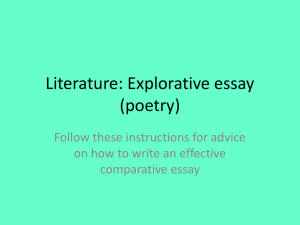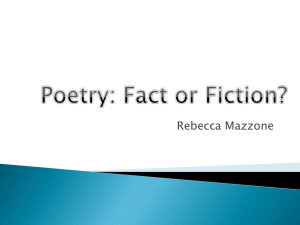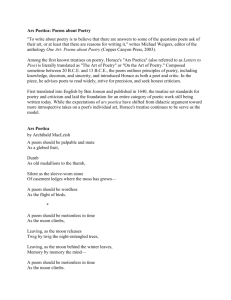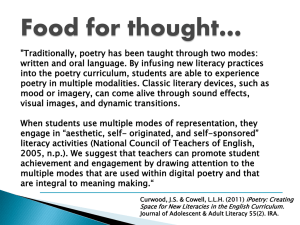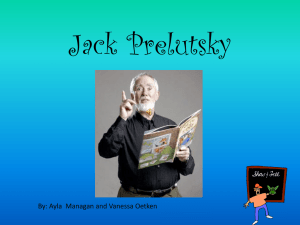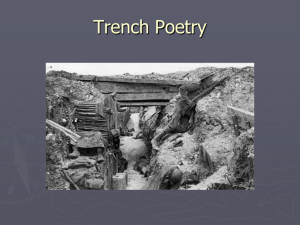4th Grade Poetry Writing Unit: Imagery & Figurative Language
advertisement
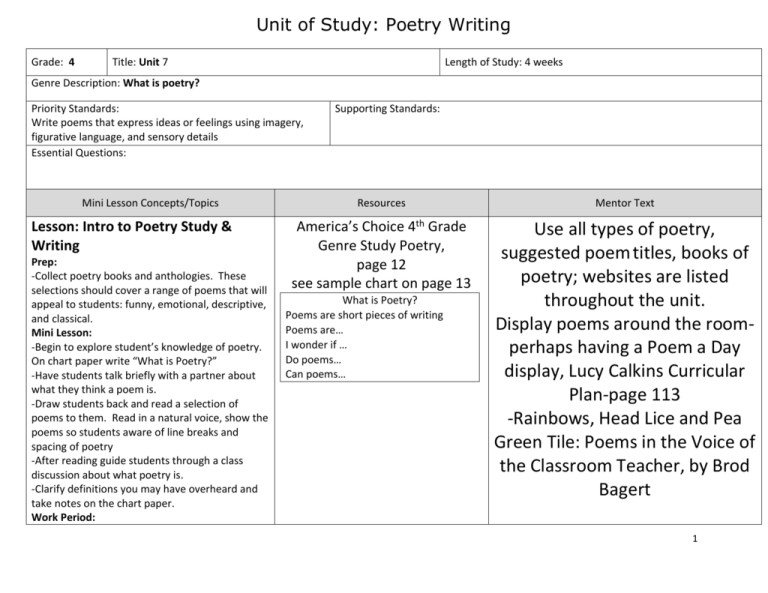
Unit of Study: Poetry Writing Grade: 4 Title: Unit 7 Length of Study: 4 weeks Genre Description: What is poetry? Priority Standards: Write poems that express ideas or feelings using imagery, figurative language, and sensory details Essential Questions: Mini Lesson Concepts/Topics Lesson: Intro to Poetry Study & Writing Prep: -Collect poetry books and anthologies. These selections should cover a range of poems that will appeal to students: funny, emotional, descriptive, and classical. Mini Lesson: -Begin to explore student’s knowledge of poetry. On chart paper write “What is Poetry?” -Have students talk briefly with a partner about what they think a poem is. -Draw students back and read a selection of poems to them. Read in a natural voice, show the poems so students aware of line breaks and spacing of poetry -After reading guide students through a class discussion about what poetry is. -Clarify definitions you may have overheard and take notes on the chart paper. Work Period: Supporting Standards: Resources Mentor Text America’s Choice 4th Grade Genre Study Poetry, page 12 see sample chart on page 13 Use all types of poetry, suggested poem titles, books of poetry; websites are listed throughout the unit. Display poems around the roomperhaps having a Poem a Day display, Lucy Calkins Curricular Plan-page 113 -Rainbows, Head Lice and Pea Green Tile: Poems in the Voice of the Classroom Teacher, by Brod Bagert What is Poetry? Poems are short pieces of writing Poems are… I wonder if … Do poems… Can poems… 1 Unit of Study: Poetry Writing -Assign students to work in groups or pairs -Direct them to browse through poems and find one to read together. Guide their read aloud, soft enough to hear the music of poetry. -Students should discuss feelings, connections to their own lives, new understandings gained Closing: -Ask students to return to the meeting place and share poems they enjoyed reading in their small group. Lesson: Continue to introduce the unit. Tell the students they are going to become poets and will see and think and write differently. Prep: -Select six to ten poems, students can comprehend. Mini Lesson: -In small groups have students read the poems. - From these poems, on chart paper or doc camera, so students can see the poems, read and discuss the poems. Create a “Guide for Reading Poetry” anchor chart Work Period: -Work in small groups again to select a poem to read aloud to the class. -Instruct them to plan how they will read the -Toes in My Nose and Other Poems, by Sheree Fitch -Poetry Party, by Bruce Lansky America’s Choice 4th Grade Genre Study Poetry, page 14 Sample Chart page 15 Guide for Reading Poetry Read in a natural voice Read the poem all the way through without stopping Read with expression Pause slightly at the end of the lines Pause at the white space Do not read too fast Do not read too slow -I Can Read with My Eyes Shut! By Dr. Seuss -Shel Sliversten -Jack Prelutsky -Lee Bennett HopkinsWebsites: http://www.pages.drexel.edu/~dea22/p oets.htm http://www.poetryfoundation.org/childr en/ 2 Unit of Study: Poetry Writing poem and to practice reading as a group. -Tell them to be prepared to explain why they decided to read in that way. -Have enough poems so no poem is read by more than two groups. Closing: -Groups read their poems, help them articulate why they read the poem the way they did. Lesson: Generating Ideas-students need support coming up with topics. Poems can grow out of observations, emotions, memories, images, etc. A Curricular Plan, page 114 Prep: -Select a variety of poems to share whole class so not to reinforce the idea that poetry has to look or sound a certain way -Sourcebook Mini Lesson: pick and choose from below what works best for developing ideas/topics to write about -Combining selected poems with sourcebook entries model how these could lead to topics to write about -Circle or copy a line from previous sourcebook entries that could turn into a poem -Look at images or go on an observation walk with pencil and sourcebook; write what they see, notice, make them think -Create a chart of where to find ideas-books read movie/TV shows, dreams, memories, something heard, etc. -Model the sense of being alert to the visual details around you A Curricular Plan for the Writing Workshop, Grade 4, 20112012/Unit Six Poetry, page 114 The Power of Poems, by Margriet Ruurs, chapter 3 3 Unit of Study: Poetry Writing Work Time: -In Sourcebook have students generate ideas they could write poems about Closing: -Students share some of their ideas Lesson: Writing Activity- Inside Me Poem Prep: -Your Sourcebook -Materials to model Inside Me poem Mini Lesson: -Explain to the students there is more inside them than organs and blood -Give questions to think about…What makes you tick? What gets you excited? What do you do outside school? Are you passionate about sports, music? -Model writing an “Inside Me” poem about you, focusing on what you like, dislike, etc. Don’t try to be perfect, write from your heart. -Explain their poems can rhyme or not rhyme. -Even though a topic was suggested, they can be free to decide what about them is important. Work Time: -Students work on writing a poem about themselves -Teacher conferences Closing: –Author’s Chair -Have those students who want share their poems The Power of Poems, by Margriet Ruurs, Chapter 3, page 35-37 4 Unit of Study: Poetry Writing Lesson: Acknowledge the five senses in poetry Prep: -Descriptive poems for students to study -Materials to model poetry writing Mini Lesson -Tell students poems can be found everywhere. -Tell students they will focus on how poets use their senses to be descriptive in their writing. -Read a descriptive poem and discuss how our senses help us to understand a poem and we will use that in our writing -Model writing a poem and using your senses to be descriptive. Work Time: -Weather permitting take students outside. -Have them sit quietly and take in their surroundings, deciding on a focus -During this time they are taking quick notes of their observations. -Students may be ready to write their poem or may need to gather seed ideas -They may choose one thing or the whole scene to write about Closing -Invite students to share their observations -Have students give feedback Lesson: Nature Poems Prep: Gather a variety of poems about nature to read to the students Mini Lesson: -Read nature poems to and with the students America’s Choice 4th Grade Genre Study Poetry, page 31 The Power of Poems, by Margriet Ruurs, Chapter 3, page 46-47 Suggested Poems: “Owls in the Wood,” by MArgriet Ruurs “The Wind was on the Withered Heath,” by J.R.R, Tolkien “Eons, Hours and Wind,” by Brod Bagert Aska’s Animals, by Warabe Aska and David Day 5 Unit of Study: Poetry Writing -Have students close their eyes and recall a special place they know, students may use ideas from their observations during the previous lesson. -Have them concentrate on that place using their senses, use as much time as necessary for students to talk about the scenes they are creating in their minds -Those having trouble picturing such a place may need nature pictures -Model writing a poem that you have pictured in your mind Work Time: -Students write a poem or poems about the place they pictured in their head. -Do not be concerned with spelling or grammar rules Closing -Have students share the poem(s) they have written “Campfire Time” by Margriet Ruurs Any other similar poems 6 Unit of Study: Poetry Writing Lesson: Making Comparisons with Metaphors and Simile Lesson on metaphors and similes maybe taught together or take two days to cover each separately Prep: - copies of 4 to 6 poems with metaphors that your students are about recognize, read and study -find or create entry to model writing metaphor or a simile -chart paper and markers Mini Lesson: -Introduce and define both metaphors and similes -metaphor- a comparison of two unlike things “drowning in paperwork” Simile-a type of metaphor that compares two things America’s Choice 4th Grade Genre Study Poetry, Lesson 12-page 64-67 that are unlike by using the words “like” or “as” “She's as fierce as a tiger” is a simile. “She's a tiger when she's angry” is a metaphor. See Anchor Chart in Resource Column -Read from Skin Like Milk, Hair Like Silk -Brainstorm metaphors and similes developing classroom anchor charts to post. -Read a few poems with metaphors, then have the students re-read the poems together and ask them to look for comparison of two things that are not alike. -Repeat with poems that have similes -Model writing metaphors and similes. Work Time: -Students read through their entries with a Simile & Metaphor Anchor Chart Suggested poems with metaphors: “Circles” from The Place My Words Are Looking For “October Saturday” from The Place My Words Are Looking For “I Am a Root” from Brown Honey in Broomwheat Tea “Tonight in the Tub” from Touch the Poem “Words” from Laughing Tomatoes “Child Frightened by a Thunderstorm” from Knock at a Star “Spill” from Knock at a Star “Lightening Jumpshot” from In Daddy’s Arms I Am Tall “By Myself” from Honey, I Love Suggested poems with similes: “Seeds” from In Daddy’s Arms I Am Tall “Bath” from Water Music “Two Stones, One River” from Water Music “Words” from Laughing Tomatoes “Peach” from Knock at a Star Skin Like Milk, Hair of Silk: What Are Similes and Metaphors? By Brian Cleary 7 Unit of Study: Poetry Writing partner and look for places to add comparison and where they may have already written a metaphor or simile. -Practice writing other comparisons Closing: -During author’s chair students may either read the entry they plan to revise, tell what they are going to revise or read their entry and revisions or share comparisons they wrote during work time. Give students a day or two of writing workshop sessions to explore reading and writing poetry and trying strategies that have been taught so far in the unit. Spend this time conferencing with students about their poetry writing. 8 Unit of Study: Poetry Writing Lesson: Personification Prep: -Gather poems with and examples of personification Mini Lesson: -Introduce students to the term personification and tell them this is another strategy poets sometime use to help the reader understand their poem(s) -Read poems to the students and then together, noting personification as you/they read -Create a list of personification possibilities with the students. What kind of traits or actions can they attribute to an animal or an object. -Write a word or phrase on chart paper and ask students for suggestions for personification, -To get students to give suggestions tell them to think of words that relate to them, especially verbs -Model writing a poem that has personification Work Time: -Students practice writing poems using personification Closing: -Invite students to share what they have written, be it a poem or examples of personification they are going to use in their writing. America’s Choice 4th Grade Genre Study Poetry, Lesson 16, pages 85-86 The Power of Poems, by Margriet Ruurs, Chapter 3, page 78 Personification Anchor Chart Suggested poems for personification: There’s a Mouse in My House, by Sheree Fitch “The Dodo,” by Peter Wesley-Smith. From: For Laughing Out Loud, selected by Jack Prelutsky “Morning Sun” and “Spring” from Laughing Tomatoes Poems by Shel Silverstein Allow students a few writing workshops to create poetry as you conference with students. Make sure students have a number of poems they 9 Unit of Study: Poetry Writing have been developing. The next few lessons will be editing and publishing Lesson: Critiquing Prep: Student writing, access to anchor charts Mini Lesson- Critiquing -Explain the difference between critiquing and editing, let students know they will critique and then edit. -The following questions are suggestions to use to see how students are feeling about their writing*Is the writing going the way you wanted it? *Are you happy with it? *Does the poem say what you wanted it to say? *Are your words painting the pictures you see in your head? -Use a poem that was developed in a previous lesson to model critiquing a piece of poetry -Suggestions to use to make changes *How would this sound if…. *What if this sentence were changed around to make it easier to rhyme with? *Should this be a rhyming poem? Work Time -As the teacher works with individual students peer conferencing can also be happening. -The criteria for peer conferencing needs to taught and modeled beforehand *I like your poem because… *What I don’t like about it is… *You have used alliteration/metaphor/simile and this is what I think about…. *The rhythm, the beat works/is off -Have students thinking about which poem(s) The Power of Poems, by Margriet Ruurs, Chapter 4, pages 82-84 10 Unit of Study: Poetry Writing they would like to publish Closing -Have students share what changes they made -Students could share what they critiqued during peer conferencing -Students could share which poem they are considering taking to publication. - Lesson: Editing and Publishing Prep: -Student sourcebooks containing the poems they have written during this unit. Mini Lesson: -Share with students that editing poetry is difficult because poetry does not always follow the rules of standard English. -Discuss how poets edit with the reader in mind and make choices about the following: *periods/no periods *capitalization/no capitalization *grammar, spelling, punctuation -Teach students to edit their poems for consistency in the grammar rules they, as the poet, have chosen to observe -Editing poetry is about sound, have students read their poems aloud several times, checking that it reads the way they want it to sound. Closing: -Consider holding a performance so students can share a poem they have written and/or a favorite mentor poem to memorize and perform. A Curricular Plan for the Writing Workshop, Grade 4, 20112012/Unit Six Poetry, page 121122 11 Unit of Study: Poetry Writing Each student should have at least one poem they take to publication, but students could also create anthologies of the poems they have written, illustrations should be included. On Demand Writing Prompts: Common Formative Assessment Tasks: Checks for Understanding 12

